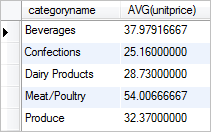Browse other questions tagged sql count group-by having or ask your own question. SQL HOME SQL Intro SQL Syntax SQL Select SQL Select Distinct SQL Where SQL An Or, Not SQL Order By SQL Insert Into SQL Null Values SQL Update SQL Delete SQL Select Top SQL Min and Max SQL Count , Avg, Sum SQL Like SQL Wildcards SQL In SQL Between SQL Aliases SQL Joins SQL Inner Join SQL Left Join SQL Right Join SQL Full Join SQL Self Join SQL Union SQL Group By SQL Having SQL Exists SQL Any. So könnten wir zum Beispiel nur diejenigen Warenhäuser anzeigen lassen, die einen Umsatz von mehr als 1. Mit WHERE kann man nur einen bestimmten Bereich einschränken, sobald man Werte gruppiert und Einschränkungen anhand der Gruppierung machen möchte, benötigt man HAVING. Gerade für die weiteren SQL Funktionen, auf die wir im nächsten Teil eingehen werden, wird HAVING häufig benötigt. Der SQL Befehl HAVING kann man als WHERE des GROUP BY bezeichnen.

HAVING folgt immer dem GROUP BY, kann also nicht davor stehen. Mit HAVING kann man die Ausgabe auf. HAVING filters records that work on summarized GROUP BY. HAVING requires that a GROUP BY clause is present.
In Minuten aktiv, keine Setup- und Abo-Kosten. MAX() with Count function. In that case, your concern should be accuracy of the result before performance. We often use the HAVINGclause in conjunction with the GROUP BY clause to filter group rows that do not satisfy a specified condition.

You could also use the SQL SUM function to return the name of the department and the total sales (in the associated department). APPLIES TO: SQL Server Azure SQL Database Azure SQL Data Warehouse Parallel Data Warehouse. Specifies a search condition for a group or an aggregate. HAVING is typically used with a GROUP BY clause.
HAVING can be used only with the SELECT statement. The following query selects all the orders that have at least line items. The GROUP BY makes the result set in summary rows by the value of one or more columns. Each same value on the specific column will be treated as an individual group. The resulting SQL statement might look like this: SELECT titles.
AVG(titles.price) FROM titles INNER JOIN publishers ON titles. Artikel wird ausgegeben. I do not remember having seen such a flow diagram of a SQL statement,. This example returns a list of items only where the whole group meets the criteria of the Having clause, that is only items of which there are more than , and none of which cost more than $500.
This is an example of linking multiple expressions together by logical operators such as AND and OR. Oracle GROUP BY HAVING will group values that have a particular value. Meseleyi daha iyi izah edebilmek için hemen örneklere geçelim. COUNT : Ermittlung der Zeilen bzw. Mnie to bardzo pomogło intuicyjnie zrozumieć istotę działania HAVING.
Ask Question Asked years, months ago. We will use the employees table in the sample database for the demonstration purposes. SQL - Having Clause - The HAVING Clause enables you to specify conditions that filter which group appear in the.
The having clause gives a filter for these group rows. I want to write to convert the sql query in a mdx Query. Es werden alle Datensätze gezählt, deren Wert nicht NULL ist.
Datenquellen auf ihre Richtigkeit zu vergleichen. Die SQL Count -Funktion wird oft verwendet. So, the count equals 16. Using Subqueries in the HAVING Clause. Because of this, it becomes very useful in filtering on aggregate values such as averages, summations, and count.
So if I wanted to set the uniquness to then only row with Value A would be collected. Otra cosa que la gente puede querer hacer es limitar el resultado según la suma correspondiente (o cualquier otra función de agregado). Read this article for more information about aggregate functions available in SQL. In TERADATA, we can also specify the position of columns in GROUP BY clause rather than specify the complete column name.

Hence below query will also output same result set.
Keine Kommentare:
Kommentar veröffentlichen
Hinweis: Nur ein Mitglied dieses Blogs kann Kommentare posten.